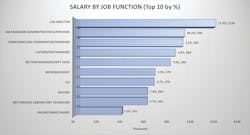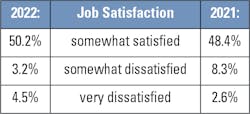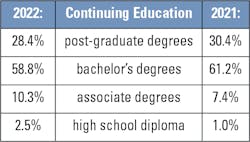MLO’s 2022 Annual Salary Survey of laboratory professionals
The results of Medical Laboratory Observer’s 2022 annual salary survey of laboratory professionals indicate a drop in the average salary across all positions; however, some specific job categories reported increases.
According to MLO’s 2022 salary survey, the average compensation, across all positions, dropped to $92,146 from $97,888 in 2021. Females’ salary also showed a drop for 2022, with reported salaries at $90,478, compared to 2021, where females’ salary was $95,270. Additionally, salaries for males fell to $98,167 in 2022, as opposed to $103,233 for 2021.
While the average compensation, across all positions, decreased in 2022, there appears to be a reasonable explanation for this drop. A notable reason has to do with the level of job responsibilities of those who responded. For instance, within the current survey, lab directors responded less than in the previous year (11.9% in 2022, 20.5% in 2021) than medical lab technicians (3.7% in 2022, up from 1.3% in 2021), therefore, causing, perhaps, slightly exaggerated results.
Many participants reported pay increases over the past year, with 73.3% “yes” responses, an improvement over 62.5% from the previous survey in 2021. Respondents also indicated they expected a salary increase in 2022, with 50.6% expressing that thought, a 2-4% rise, whereas 48.4% of 2021 respondents expressed their expected 2-4% increase. A less than 2% anticipated annual increase dropped to 20.2% of the 2022 survey takers, in comparison to 20.8% in 2021. Bonuses where positively affirmed for 2022, at 48.1% over 2021’s 38.1%.
Demographics
Of the 243 survey respondents, where both male and females were represented, the majority were female (76.1%) over 2021’s 71.5%. However, the collective percentages of both represented genders were: 37.9% between the ages of 56-65, and 22.6% ages of 46-55. These men and women hold salaried, management positions (74.9%), with the majority working in hospital labs, where an increase to 96.3%, over 2021’s average of 93.9% was reported.
Salary changes: ups and downs across positions and locations
While expected annual base salary for 2022 is $92,146, this survey shows that salaries, based on particular positions, fluctuated since 2021 with more salaries dropping, over the past year. Pathologists’ salary decreased in 2022, to $147,750, from 2021’s $160,000. Microbiologists also saw a decrease in their salary in this 2022 survey, dropping to $70,357, from 2021’s $73,750. Lab directors reported a downward trend in their 2022 salary ($123,500), as well, indicating a slight difference from last year’s numbers ($126,938). Other areas where salary losses occurred were medical lab technicians, $63,389 for 2022, down from 2021’s $65,000; medical laboratory scientists, $63,559, for 2022, dropping from 2021 ($80,500); and chief/asst. chief/medical technologist reporting a salary decrease from 2021 ($86,833), currently at $75,833, for 2022.
In contrast to the descending salary trends above, lab managers/administrators/supervisors’ salaries increased from $93,879, in 2021, to $96,246, in 2022. Compliance/quality assurance coordinators and managers’ salaries also increased in 2022, to $94,677, over 2021’s salary of $87,000. Section managers and department heads also saw an increase in salary for 2022 ($83,735), rather than 2021’s salary of $77,703. Lastly, LIS/EHR/EMR managers’ salaries, for 2022, rose to $88,083, from 84,500 in 2021.
Aligning with the current trend, salaries designated by regions also exhibited fluctuations, with more of a downward tendency, rather than an upward one. The northeast saw a significant downward turn in 2022, with salaries at $83,816, as opposed to 2021’s result, $98,110. The central region also experienced a salary drop to $90,241 in 2022, from $92,747 in 2021. The mountain region’s salary fell in 2022, to $97,444, from $101,817, in 2021.
Unlike the regions mentioned above, two regions experienced a rise in salary in 2022. The southeast region gained in 2022, with $94,727, over that of 2021 ($92,069). Additionally, the pacific region also experienced an increase in salary in 2022, ($130,125), which outshines the previous year’s salary of $129,208.
Lab size and testing volume influence salary
To further clarify the differing salary results for 2022, salaries, based on the number of employees a lab employs, appears as a “mostly” downward trend from 2021. Labs with over 100 employees reported an average salary, for 2022, at $95,536, down from 2021 ($115,873). Labs that employ 51-100 people showed an average salary of $95,052, for 2022, a reduction from $101,535, in 2021. Those labs that have 21-50 employees reported average salaries at $91,052, for 2022, falling below 2021’s average of $91,336. Those labs with 1-10 people employed have average salaries of $80,758, whereas 2021’s average for salaried employees from the same size lab was $83,128. The only labs experiencing an average salary increase have an average of 11-20 employees, and an average salary of $92,267, in 2022, rather than $86,560, in 2021.
Testing volume of laboratories influenced average salaries in 2022, down, for the most part, from 2021. Labs that performed more than two million tests experienced a drop in average salary, from $115,516, in 2021, to $109,709, in 2022. The downward trend continues across labs with lower testing volumes.
The only labs where the average salary increased were those with 100,001 to $500,000 tests, where average salaries were $94,173, in 2022, an increase from 2021 ($91,053).
Salary by degree and gender: males surpass females
Among those reporting salary information, degree and gender differences hold evidence that suggests higher average salaries among males, at the post-graduate and bachelor’s degree levels.
Males with a post-graduate degree earn, on average, $107,500, a higher salary than females, with the same degree, $106,367. Males with a bachelor’s degree, again, earn more than their equally degreed female counterparts. Males earned, on average, $97,833, whereas females earned $91,801. The opposite results appear for employees who hold an associate degree, with females earning higher salaries, on average than males with the same degree. Associate degreed females top males with an average salary of $62,773, to males $55,833.
Job satisfaction is down, at the highest level; job security is on the rise
Those surveyed reported that their job satisfaction was down from 2021, with 32.1% very satisfied, as opposed to 2021 figures (40.7%). However, other categories showed an uptake from 2021:
2022 job security figures demonstrated an increase, at the highest level, with 60.5% reporting they feel very secure in their jobs, up from 54.5% in 2021. However, another increase occurred among those who feel very insecure in their jobs, with 2022’s figure (2.9%) rising from 2021 (1%). A drop occurred in the other two categories: 35% somewhat secure (2022) and 1.6% somewhat insecure (2022) from 2021’s figures (40.4% somewhat secure and 4.2% somewhat insecure).
Decrease in most benefits
During 2021 and 2022, nearly all respondents said their employers offer health insurance, dental insurance, vision, and a 401K plan or pension. However, overall benefits declined during 2022.
Life insurance showed a drop from 2021 (85.9%) to 2022 (82.7%). Paid time off (PTO) is down from 87.2% in 2021, to 86% in 2022. Disability insurance is also lower in 2022 (75.7%), dipping slightly from 77.6%, in 2021. Flex time, in 2022, fell to 11.1% from 12.2% in 2021. Paid holidays for 2022 also dropped to 58.4%, whereas 2021 showed 62.5%. Childcare is down in 2022 (4.9%), as opposed to 2021’s figure of 6.4%.
The only area where benefits increased was overtime, where 2022 figures show 45.3%, over 2021’s 30.8%. Additionally, paid COVID-19-specific leave was reported at 30.9% in 2022.
Stacie Bledsoe, Lab Director, The Medical Center, Bowling Green, KY, explained that her lab “offered existing employees incentive pay for covering open shifts.”
Education, certifications, and CEUs
Labs, in 2022, as in 2021, continue to employ those workers with a bachelor’s degree as their highest level of education.
In addition to degrees listed above, continuing education units (CEUs) also remain a necessary part of the laboratory world. In 2022, 19.8% logged more than 20 hours of CUEs and 30% logged between 11-20 CEU hours. Bledsoe also indicated the acquisition of CEUs “do not affect salary.”
The three most common certifications, from professional organization, remain constant from 2021, with 2022 results revealing the following:
- American Society for Clinical Pathology: 73.7%
- State government:
- 15.6%
- National Credentialing Agency for Laboratory Personnel (NCA):
- 11.9%
Tenure results illustrate longevity at the highest level
The current tenure results within the 2022 survey demonstrate consistency of employment, with 21.8% of employees working for more than 30 years with their current employer. Other figures, while not as impressive, still show overall stability within the laboratories surveyed. 2022 results show 8.2% of employees have worked for their current employer for 25-30 years; 10.7% for 20-24 years; 10.3% for 15-19 years; 12.8% for 10-14 years; 12.3% for 6-9 years; 8.2% for 3-5 years; and 15.6% for less than 3 years.
Laboratory operations and management
Those surveyed revealed results regarding the impact of the current shortage of medical personnel, on their labs’ operational efficiency, as largely impacted, with 43.2% reporting, compared to 2021’s figure of 26.3%. Moderate impact was reported at 40.3%, in 2022, down from 2021 figures (54.2%). Low impact for 2022 (14.8%) was down slightly from 2021 (15.7%). Those reporting no impact to their labs’ operational efficiency for 2022 delivered a slight decline (1.6%) from 2021’s figure. (3.8%).
Bledsoe also shared how personnel shortages, primarily in the phlebotomy and night shift tech departments, impacted her lab and the solutions that ere implemented.
“We have dealt with phlebotomy and technical staff shortages over the last 2 years,” she said. “Since then, our facility has increased our facility minimum wage to be more competitive in the job market for phlebotomy. As far as our technical staff, we have begun a partnership with University of Kentucky’s MLS program and were able to retain 2 students as techs. We also started training Medical Laboratory Assistants to do some more non-technical things to assist our techs.”
When asked if the current shortage of medical personnel pressed labs to outsource more tests during 2020, 28.4% replied “yes,” (up from 22.8% in 2021), and 71.6% said “no.”
Conclusion
The MLO salary survey depicts those dedicated, well-educated, adaptable professionals who are, for the most part, secure in their positions, if not as satisfied as they would like. Perhaps the idea of unequal compensation, based on gender, despite the similarities in education, could explain that frustration.
Gail Castanho
Managing Editor, MLO




